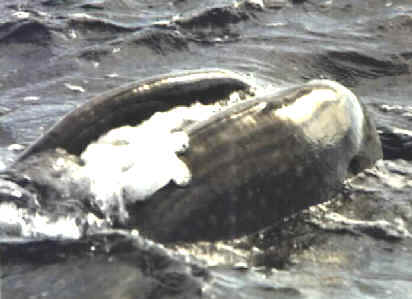 PO
Box 9021, Wilmington, DE 19809, USA
PO
Box 9021, Wilmington, DE 19809, USAE-mail: font@focusonnature.com
Phone: Toll-free in USA 1-888-721-3555
or 302/529-1876
 PO
Box 9021, Wilmington, DE 19809, USA
PO
Box 9021, Wilmington, DE 19809, USA
E-mail: font@focusonnature.com
Phone: Toll-free in USA 1-888-721-3555
or 302/529-1876
Whale
sharkS
&
Some Other marine life
in waters off the
coast
of Mexico's Yucatan Peninsula
With notes compiled by Armas Hill
Links:
Birds of the Yucatan Region of Mexico
Birds of Cozumel Island, Mexico
Mexican Mammals & Other Wildlife, including Amphibians &
Reptiles
Upcoming FONT Birding & Nature Tours in Mexico & Belize

A mouth of a Whale Shark
photographed
during a FONT tour
(photo by Marie Gardner)
The Whale Shark, Rhincodon
typus,
is the largest known fish in the world, and the largest known cold-blooded
vertebrate.. It can reach up to 14 meters (42 feet)
in length, but typical adults are between 7 meters (21 feet) and 10 meters (30
feet) long.
It has an enormous head, that is wedge-shaped in side profile, flat-fronted, and
squarish from above, and it has small barbets, and a cavernous mouth-opening 1.5
meters (almost 6 feet) wide. (See photo above.)
There are hundreds of tiny, hook-like teeth in each jaw.
Its eyes are inconspicuous, closed by retracting and rotating the eyeball
backwards in its socket.
The tail-fin of the fish is huge, about one-third of the total body
length.
Another name for the fish is the Domino Shark, coming from its distinctive black
skin covered in rows of white dots.
The lifespan of the Whale Shark is long. It can typically live into its 70s.
The Whale Shark is a true shark. Its name, of course, is due to its large size.
Unlike vicious Great White Sharks, Whale Sharks are gentle filter-feeders.
Plankton is its primary food. When feeding, Whale Sharks glide in circles, as
they simply suck up whatever small sea-life is front of them.
Often seen accompanying Whale Sharks are young Golden Trevally, Gnathanodon
speciosus.
Although Whale Sharks populate the tropical zone around the globe, the shallow
waters off the north coast of the Mexican province of Quintana Roo, on the
Yucatan Peninsula, is the ONLY PLACE in the world where a very large population
gathers. They occur, there, in pods of ten or twenty, and it has been estimated
that total number there, in the waters, is MORE THAN 200. This apparently is due
to the swirling waters where the Gulf of Mexico meets the Atlantic Ocean. Those
waters teem with plankton, noted as the Whale Shark's favored food.
The highest number of Whale Sharks off the northern Yucatan Peninsula is said to
be in the summer, although it does occur at other times.
Other notable fish and marine-life also occur in those waters. Over a hundred
significant marine species live there including: swordfish, snapper, bonefish,
tarpon, and mackerel.
A variety of sharks cruise the reefs off the Yucatan Peninsula, as do a variety
of rays.
Sharks there include Tiger Sharks and Nurse Sharks. Others in the West Atlantic
Ocean include: Lemon, Reef, Bull, Blacktip, Whitetip, Blue, Silky, and Hammerhead.
Rays that are common in the tropical West Atlantic Ocean include: Stingrays,
Eagle Rays, and Cownose Rays.
The Spotted Eagle Ray is one of the most striking and attractive.
Manta Rays, or "Devil Rays", are common around outer reefs. In spite
of the name "Devil Ray", mantas are large, docile creatures. They
reach up to 22 feet from wingtip to wingtip.
Manta Rays have large mouth flaps that are movable and guide food to the
slot-like mouth. There are hundreds of tiny pillar-shaped teeth in the lower jaw
only.
Manta Rays waters in which they
feed on small crustaceans and other planktonic food. They seem graceful as
they glide through the water, and sometimes they can be seen leaping clear of
the water's surface.
Click this link for a list of TROPICAL FISH IN THE REEFS OFF THE YUCATAN OF
MEXICO & BELIZE.
There are upcoming FONT birding & nature tours to areas with reefs & marine-life in the
Yucatan Region in Mexico, and in nearby Belize. For info, you may click the link
at top of this page.
![]()
Web page by Risė Hill